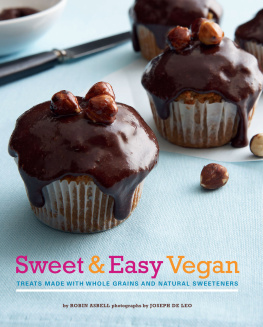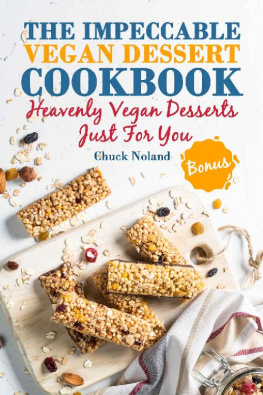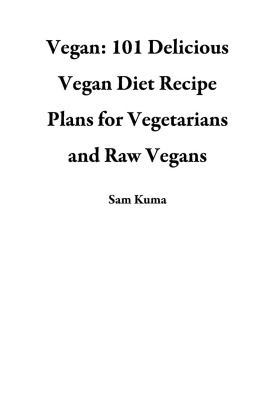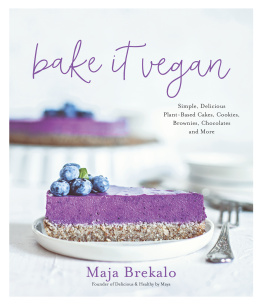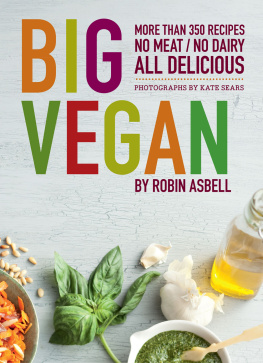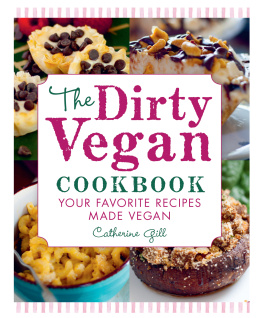I dedicate this book to my late, great friend John Taylor, who encouraged me to write starting with my first article, years ago. He tasted my recipe tests for this book and gave me support and love to the end.
Of course, my sweetheart, Stan, my sister, Rachael, and my family and friends deserve my overflowing gratitude for helping me along the way. My agent, Jennifer Griffin, was there with great insight, hand-holding, and advice, even as she grew her family by one.
I owe great thanks to my diligent recipe testers: Melodie Bahan, Lisa Genis, Jill Jacoby, Marge Porter, Cathy OKeefe, and Anita Bothun.
The talented people at Chronicle Books deserve much of the credit, with Amy Treadwell, Bill LeBlond, Doug Ogan, Tera Killip, and Alice Chau making sure that everything makes sense; Peter Perez and David Hawk shepherding my books into the bookstore; and a talented photographer giving the food the presence it has in the pages of the book.
Big hugs to the supportive friends who helped along the way: Fran Costigan, Linda Long, Jill OConner, and all my IACP colleagues who share so much.
Many thanks to all the wonderful people who read my work and come out to see me at classes and demonstrations. I couldnt do it without you!

Everybody loves sweets. Omnivores and vegans alike have a deep desire for the occasional treat, and why not? A cookie here and there adds joy to life, and if your diet is generally balanced, it really isnt a problem. Killjoys may recommend giving up eating sweet treats, but the fact is, most people like them: you like them, your family likes them, and they arent going away anytime soon.
This book is my answer to the sweets craving, in which the sweets you eat are as nutritious and healthful as I can make them without sacrificing the pleasure of sweetness. Im not claiming that eating these treats will make the pounds melt away; Im simply trying to make sure that when you decide to eat a cookie or other sweets, they will be packed with real food, like whole grains, fruit, and nutsand sweeteners in as unrefined and natural a state as possible. Junk food is just empty calories, but these calories are nutrient-dense. In fact, you may find that eating high-fiber, nutritious treats is so much more satisfying that you eat less of them as a result.
You dont have to adhere to any particular diet, vegan or otherwise, to enjoy these treats. I found that one of the great joys in developing the recipes for this book was sharing my treats with friends, neighbors, and coworkers who werent particularly vegan or into whole grains. Their glowing and enthusiastic praise was encouraging. Beyond letting me know these recipes are truly tasty, the positive response proved beyond a shadow of a doubt that people would come around once they actually got a bite. The proof is in the puddingor the scone, cake, cookie, or biscuit, as the case may be.

CHOOSING SWEETNESS
For most bakers, the main sweeteners are white sugar and brown sugar (which is simply white sugar with some molasses mixed in). These sweeteners make life simple. Although they are familiar and therefore easy to cook with, they have some serious downsides. White sugar is made from sugarcane juice or sugar beets that have been refined to remove essentially all vitamin and mineral content, and the spritz of molasses that coats brown sugar contributes almost no nutrients. Whether in the form of refined sugar or high-fructose corn syrup, Americans eat an average of almost 1/2 cup/110 g of sugar per day and by some estimates the average person in the United Kingdom consumes his or her own weight in sugar each yearplus 20 lb/9 kg of corn syrup. Thats an awful lot of calories to dedicate to something with no nutrients other than fast-burning carbohydrates.
Still, our desire for sweetness is a natural part of our physiology. In our not-so-distant hunter-gatherer past, sweetness was a signal that a fruit or vegetable was ripe and at its most nutritious. Finding a patch of ripe berries or a date palm dropping sugary fruit was a chance to get valuable nutrients that perhaps hadnt been available for a while. Sitting down to a feast and stuffing in as much as you could was a smart way to survive. Unfortunately, that drive has remained even as the world around us has become a twenty-four-hour buffet, too often filled with refined, processed, nutrient-poor foodstuffs. Instead of the scent of wild strawberries leading to a belly stuffed with nutritious fruit, rich in fiber, vitamins, and phyto-nutrients, a sniff of Cinnabon or a bag of Halloween candy can lead to a binge on sugary, high-fat foods.
It should come as no surprise that manufacturers know what you like and are happy to sell it to you. Sugar and high-fructose corn syrup are cheap and make junk food taste good. They hit your bloodstream with a surge of pure sugar, almost like a drug. For vegans, theres also the downside that in some cases the processing of refined cane sugar involves filtration through bone char. The Vegetarian Resource Group estimates that 20 percent of the white sugar sold in the United States is filtered this way. The best answer to your innate drive for sweets is to make your own treats using real, whole foods and sweeteners that are as close to their natural state as possible, which ensures that they deliver not just sweetness, but also superior nutrition.
REAPING THE REWARDS OF SUPERIOR NUTRITION
Before refined sweeteners became such a cheap, readily available source of sweetness, people found other ways to sweeten foods. Those less-refined sweeteners are less like drugs and more like food. They are wholesome and still contain many of the nutrients of the plants they were made from. A study published in the Journal of the American Dietetic Association in 2009 took a look at just one nutritional difference between sugar and alternative sweeteners: antioxidant content. The researchers found that there are no antioxidants in sugar or corn syrup, but varying degrees of antioxidant activity in natural sweeteners (other than agave syrup). Molasses, date sugar, brown rice syrup, and barley malt syrup had the highest antioxidant content, while maple syrup and rapadura cane sweeteners were just below them. The researchers concluded that replacing the average daily intake of refined sweeteners with antioxidant-rich alternative sweeteners could increase antioxidant consumption as much as eating a serving of blueberries or nuts.
Navinda Seeram, a plant scientist at the University of Rhode Island, has devoted a great deal of research to maple syrup. In 2011, he announced that he has identified fifty-four beneficial compounds in maple syrup, some with antioxidant and anti-inflammatory properties. The maple trees apparently produce these chemicals as part of their immune response to the wounds made to tap the syrup, and when we consume these compounds, they act to boost our immunity, as well. In addition, maple syrup is high in the minerals manganese and zinc, which also function as antioxidants and are crucial for many processes in the body.
The terms evaporated cane juice and dehydrated cane juice may be applied to a broad range of alternative sweeteners. All have the advantage that you can substitute them, in an equal ratio, for white or brown sugar. Some are made by fully refining sugarcane juice and then adding back in a bit of the molasses removed during the refining process. These sugars are shiny and crystalline, a sure sign that they are heavily processed. Other cane sugar products are superior, particularly rapadura, a type of sugar made by drying sugarcane juice, so it still contains most of the original molasses content, along with its minerals and antioxidants. Sucanat is a brand name for this type of sugar. I suggest that you choose Sucanat or rapadurajust be aware that these sugars have a stronger flavor. They also dont melt the way that refined sugars do, but they do bring distinctive and delicious sugarcane flavor to sweet treats.

